Water Quality Management for Healthy Gut in Chicken
- R&D
Dr. Ashok Rajguru, Programme Manager, Trouw Nutrition India
Water is the most important nutrient for poultry. Water plays a key role in thermoregulation, digestion and absorption of nutrients and acts as a carrier for administration of additives, such as medication, supplements, etc. Excellent water quality is important as chickens consume twice as much water as feed. Chick’s body weight contains 70% of water but if water intake is reduced or there is increased water loss, then it would have a significant effect on the bird’s performance. Therefore, it is very important to ensure that adequate, clean and uncontaminated water supply is provided to the chicken.
Figure1: Supply of clean water to birds
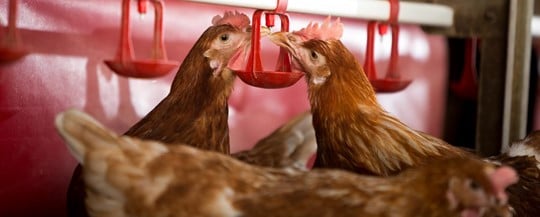
When we analyze water samples for chemical parameters, we may observe higher level of inorganic elements such as sodium (Na), potassium (K), and chloride (Cl). This might lead to increased water consumption leading to wet droppings and poor litter conditions. Many a times, main source water and pipeline water could contain higher levels of calcium salt (hardness), high alkalinity and high level of nitrate, which need to be taken care of whilst addressing water quality. Also, the pipeline water samples should be regularly monitored for contamination with biofilms (Fig. 2) which would affect the quality and quantity of water intake. Biofilms will affect bird performance consequent to the reduced effectiveness of medication & vaccination, reduced nipple flow rate and increased bacterial disease mortality.
Figure 2: Pipeline water biofilm

Sanitization of water can be carried out by Chlorination, Chlorine dioxide, Hydrogen peroxide etc. Sanitation of water should be coupled with acidification, for the sanitizers to act effectively and for synergistic effect with respect to microbial control. This can be accomplished by usage of apt combination of free and buffered organic acids. Selko pH from Trouw nutrition contains free and buffered organic acids which helps in maintaining good water quality along with optimal gut health conditions in birds.
Strategies to optimize water quality:
1.Acidification with Organic acid (Selko pH)
Addition of Selko®-pH in drinking water of poultry reduces and stabilizes the pH of the drinking water of animals. It supports the digestion of feed ingredients by reducing the pH in the crop and stomach. Primarily for young birds, a lower pH supports better protein digestion, as pepsin (a protease) is most active at a low pH. Less undigested protein reaching the hindgut and microbial control in the stomach results in improved performance and a healthier gut (Fig. 3, 4 & 5)
Figure 3: Improvement in performance with Selko pH over competing product
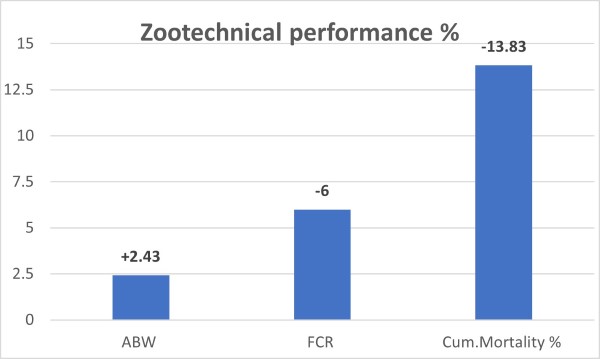
Fig. 4: Effect of Selko pH on gram negative bacteria
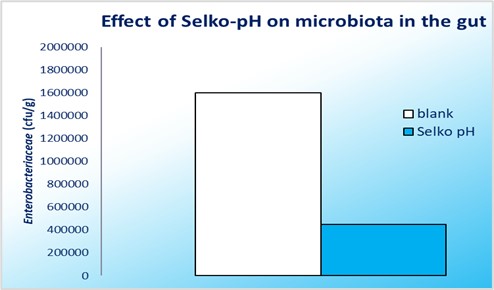
Fig. 5: Better feed digestion
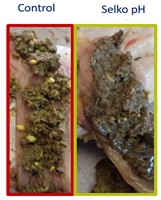
Water can be classified according to its alkalinity, or buffer capacity — a measurement of water's capability to neutralize acids. Knowing the water's buffer capacity helps determine the best blend (level of buffering) and the recommended application rate. The goal of using water acidifiers is to achieve an end pH of approximately 3.8 to 4.0. In water with high buffer capacity (high alkalinity), a higher inclusion rate of acidifiers is required to reach this target pH. Less buffered acidifiers can help reach the target pH at lower doses. A blend of organic acids may be worth considering when the objective is to combat biofilm and improve animal digestion, gastrointestinal microbial balance, or animal performance. Dosage is especially important. Higher amounts of a water acidifier will make more of the acid molecules available to the animal to support desired effects.
- Pipeline cleaning and disinfection with Hydrogen peroxide
A simple and effective disinfectant usage between cycles like hydrogen peroxide will work very well in killing many bacteria and removing biofilm buildup. It also helps to prevent biofilm formation to some extent. Applying the proper concentration of hydrogen peroxide (35 % conc.) with 1-3 % water solution and allowing adequate treatment time is important to achieve desired disinfection results. Hydrogen peroxide works best for disinfection purpose and not for regular practice or as a substitute to water acidification.
- Chlorination as maintenance during cycles
Generally, a concentration of sodium hypochlorite at 15% (100 to 150 mL/1000 L water) or chlorine dioxide applied at 0.2 to 0.4 mg/L water is recommended. The target level of residual free chlorine is important and should be between 3-5 ppm or oxidative reduction potential (ORP) in the range of 650 to 700 millivolts. Measuring the ORP in the water helps assess the balance between the water's pH and free chlorine to assure water is effectively sanitized. ORP reflects the activity of the water sanitizer as opposed to its concentration level (ppm). Chlorination becomes even more effective when combined with a proper approach to acidification. Chlorine reaction (HOCl . OCl- + H+) is pH-dependent. At a pH of 5 to 6, the chlorine species is nearly 100% hypochlorous acid (HOCl) and highly effective at killing bacteria (Fig. 6). Above pH 6, it starts to convert to the hypochlorite ion (OCl-) and acts mainly as an oxidizer. Water with a pH = 7 may need to be lowered for chlorine to achieve optimal bacteria-killing efficacy.
Fig. 6: pH dependent effectiveness of free chlorine
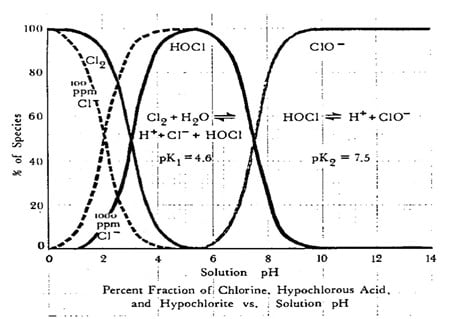
Conclusion
The microbial, chemical and physical quality of water should be monitored regularly. A good pipleline cleaning program should be in place for increasing the shelf life of pipelines and to prevent formation of biofilms. A water sanitation cum acidification protocol should be in place for improving quality of water that is been provided to birds and for optimizing their gut health conditions. Selko pH when applied in right dose in drinking water of poultry, improves the overall bird performance and can serve as an effective candidate in antibiotic free rearing practices as well.